A team on South Georgia has successfully completed the world’s largest rodent eradication in an effort to rid the British territory of millions of rats and mice.
Against the backdrop of an approaching Antarctic winter between February and May, three helicopters encountered perilous flying conditions while peppering the southern Atlantic island with 183 tonnes of the poison Brodifacoum. The team of 25 baited an area of 224 sq miles (580 sq km). The area targeted dwarfed the previous largest rodent eradication, on New Zealand’s Campbell Island, by five times.
The project director, Prof Tony Martin, said the team, managed by the Dundee-based South Georgia Heritage Trust, aimed to return the 104 mile (167 km) long island to the millions of seabirds wiped out by rats and mice introduced by 19th- and 20th-century whalers and sealers.
“South Georgia, before man came along, was probably the most important bird breeding island in the world. And it is no longer anything close to that,” he said. Probably less than 1% of the original population of burrowing seabirds remains, Martin said.
Many of the island’s animals remain unaffected by the rat population. Huge populations of seals and penguins attract thousands of cruise ship passengers every year.
However Martin said others, such as the endemic South Georgia pippit and South Georgia pintail, were clinging to existence “by their claws”. The storm petrel, Antarctic prion and cape petrel had been driven away from the vital breeding grounds. Every breeding season a single rat would eat hundreds of seabird chicks.
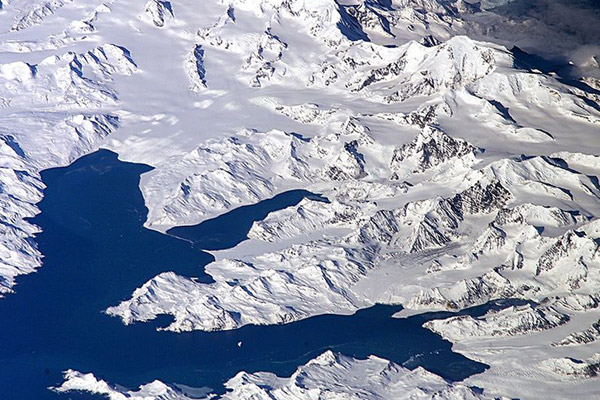
Aerial view of Cumberland Bay on South Georgia. Photo by: NASA.
He said that returning the island’s habitat to its natural inhabitants was an act of global significance and that islands like South Georgia were particularly vulnerable to introduced predators.
“What we are doing is allowing an island to go back to the way it was before man came along and screwed it up two and a half centuries ago. Invasive animals are really crucifying the world’s biodiversity.
“What you have to bear in mind is the ecosystem of South Georgia evolved in the absence of any terrestrial mammals. So when man came along at the last second of the last hour in evolutionary terms, and introduced these little furry rodents which started to eat them, they were completely naive.”
The successful poison drops marked the second phase of a three stage project.
The first stage, which was itself equal in scale to the Campbell Island elimination, took place in 2011. The South Georgia heritage trustee Howard Pearce said it appeared this phase had been successful, lending confidence to the ongoing efforts of the team.
“After two years of monitoring the work we did back in 2011, the first trial phase on South Georgia, we have found no sign of rodents in the areas we cleared then and we are now pretty confident that we were completely successful in eradicating rats from the area,” Pearce said.
Martin said that previously rare sightings of South Georgia pintails being followed by groups of ducklings were the best sign the first stage had secured the environment for native species.
He said the island’s unique topography made the project possible. Even in summer, 75% of the island is covered by ice and snow. Large glaciers cascade into the ocean, splitting the island’s habitable areas into smaller pockets. This meant that the project could treat each region in isolation.
However, said Martin, climate change had created a “race against time”. The island’s glaciers were receding at up to one meter a year, opening the already treated areas to re-infestation as the rats would use newly exposed shorelines to reclaim their territory.
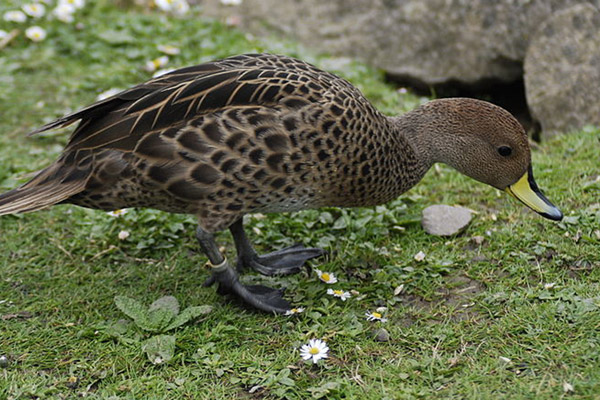
Populations of the South Georgia pintail, which is endemic to the island, have been decimated by rats. Photo by: Mehmet Karatay/Creative Commons 3.0.
Pearce said the completion of the second stage was “a fantastic achievement in very difficult circumstances”. The team were exposed to the worst autumnal weather in a decade. This made flying extremely difficult and, on most days, impossible. Helicopter pilot George Phillips said he had “never, ever experienced conditions like it”.
As time went on and the weather looked set to defeat the project, the expedition doctor, Diedre Galbraith, said the team suffered the psychological stress of uncertainty and frustration.
“As the months went by with no work, day after day after day after day of monotony it can be very detrimental to the whole team morale,” she said.
Martin said that he had private moments where he had given up hope of completing the baiting before winter drove them off the island. With days left to go, conditions cleared just enough for the team to complete the stage.
The third stage of the project is planned for 2015, subject to the South Georgia Heritage Trust raising an extra £2.5m. Unusually for a conservation project of this scale, the £7.5m cost of the entire project has been funded largely privately through fundraising by the trust. Only a small proportion of the money was supplied by the British government.
If the rats are successfully eradicated from the entire island, Martin said, it would take an enormous effort to keep the island secure from re-infestation. Cruise and supply ships are already banned from tying up to the island’s docks. Martin said that the greatest danger came from fishing boats becoming wrecked on the island’s storm-broken shore.
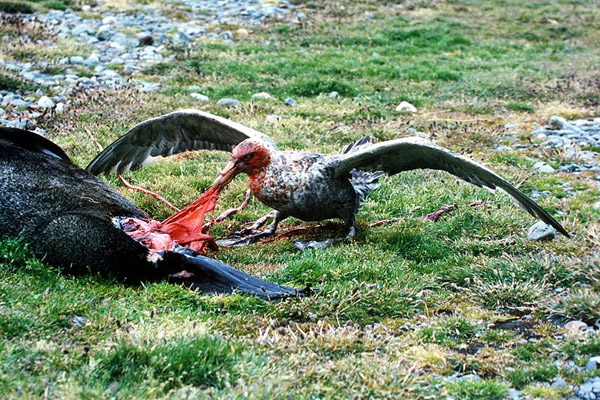
Land of the birds: a giant petrel feeds off the carcass of a seal in South Georgia. Photo by: Brocken Inaglory/Creative Commons 3.0.
Original Post: World’s largest rat extermination returns South Georgia to its bird life
Related articles
Plan to preserve the world’s ‘last ocean’ killed by Russia
(07/16/2013) As the most pristine marine ecosystem on the planet, Antarctica’s Ross Sea has become dubbed the world’s “last ocean.” Home to an abundance of penguins, whales, orcas, seals, and massive fish, the Ross Sea has so far largely avoided the degradation that has impacted much of the world’s other marine waters. However, a landmark proposal to protect the Ross Sea, as well as the coastline of East Antarctica, has failed today due to opposition by Russia.
Last 30 years were the warmest in the last 1,400 years
(04/21/2013) From 1971 to 2000, the world’s land areas were the warmest they have been in at least 1,400 years, according to a new study in Nature Geoscience. The massive new study, involving 80 researchers from around the world with the Past Global Changes (PAGES) group, is the first to look at continental temperature changes over two thousand years, providing insights into regional climatic changes from the Roman Empire to the modern day. According to the data, Earth’s land masses were generally cooling until anthropogenic climate change reversed the long-term pattern in the late-19th Century.
Temperature in West Antarctica rising twice as fast as previously thought, finds study
(12/23/2012) The West Antarctic Ice Sheet is warming twice as fast as previously believed, spurring new concerns about broader melting in Antarctica and associated sea level rise, according to a new study published in the journal Nature Geoscience.
Greenland and Antarctica ice melt accelerating, pushing sea levels higher

(12/03/2012) A massive team of scientists have used multiple methods to provide the best assessment yet of ice loss at the world’s poles, including Greenland and a number of Antarctic ice sheets. Their findings—that all major ice sheets are shrinking but one; that ice loss is speeding up; and that this is contributing to the rise in sea levels—add more evidence to the real-time impacts from global climate change. Melting ice sheets at the poles have raised sea levels 11.1 millimeters, or about 20 percent of observed sea level rise, in the past twenty years, according to the landmark study in Science.
Above the ocean: saving the world’s most threatened birds
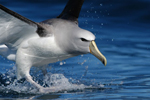
(11/01/2012) A life on the ocean is a perilous one for any bird. They must expend energy staying aloft for thousands of miles and learn to be marathon swimmers; they must seek food beneath treacherous waves and brave the world’s most extreme climates; they must navigate the perils both of an unforgiving sea and far-flung islands. Yet seabirds, which includes 346 global species that depend on marine ecosystems, have evolved numerous strategies and complex life histories to deal with the challenges of the sea successfully, and they have been doing so since the dinosaur’s last stand. Today, despite such a track record, no other bird family is more threatened; yet it’s not the wild, unpredictable sea that endangers them, but pervasive human impacts.
Photos: emperor penguins take first place in renowned wildlife photo contest
-Bubble-jetting-emperors-.150.jpg)
(10/18/2012) Photographer, Paul Nicklen, says he’ll never forget the moment when a slew of emperor penguins burst by him in the frigid Ross Sea; he’d waited in the cold water, using a snorkel, to capture this image. Now, Nicklen has won the much-coveted Veolia Environnement Wildlife Photographer of the
Year Competition for the antic, bubbling photograph. Owned by the Natural History Museum and BBC Worldwide, this is the 48th year of the Veolia Environnement Wildlife Photographer of the Year, which hands out awards to 100 notable wildlife and environment photos.
Penguins face a slippery future
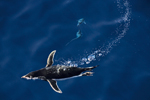
(09/26/2012) Penguins have spent years fooling us. With their image seemingly every where we turn—entertaining us in animated films, awing us in documentaries, and winking at us in commercials—they have made most of us believe they are doing just fine; the penguin’s charming demeanor has lulled us into complacency about their fate. But penguin populations are facing historic declines even as their popularity in human society rises. Overfishing is decimating some of their prey species, climate change is shifting their resources and imperiling their habitat, meanwhile pollution, such as oil spills, are putting even healthy colonies at risk. Now, a young organization, the Global Penguin Society (GPS), is working to save all of the world’s 18 penguin species by working with scientists, governments, and local communities.